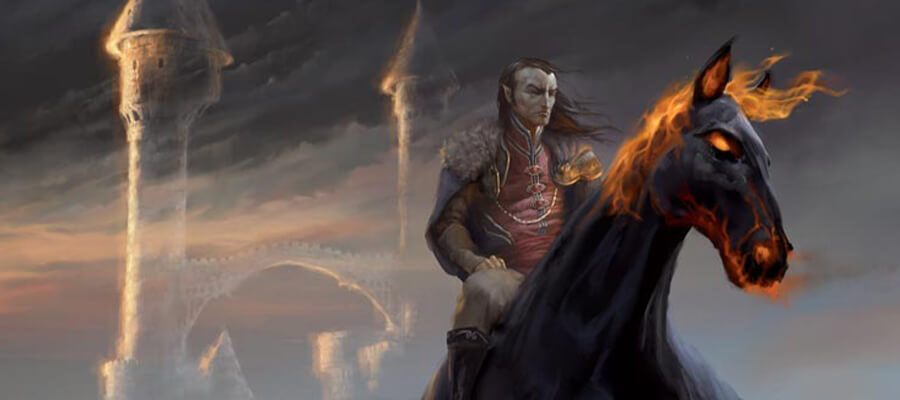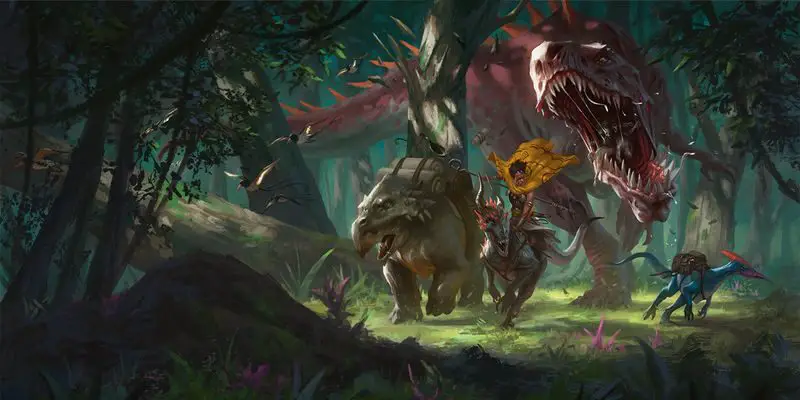How to Make a Great D&D Villain featured image is credited to Wizards of the Coast’s D&D 5e Curse of Strahd module.
Disclaimer: This article contains affiliate links that add gold to our coffers.
When it comes to villains, Dungeons & Dragons players want four things:
- They want a villain they love to hate.
- They want a villain with a real sense of presence.
- They want a villain with real flaws and limitations.
- And they want a villain who helps tell their story—not his.
A Villain Your Players Will Love to Hate
A villain isn’t a villain because they’re evil. Like Darth Vader, Scar, Frollo, It, or Thanos, a proper villain should be—at least eventually—on a first-name basis with your players. Generic evil won’t cut it—real villainy requires a personal touch. A common bandit can sate a character’s hunger for justice. A marauding dragon’s hoard can stuff an adventurer’s purse. But to satisfy a player’s need for emotional satisfaction, a DM needs to dig deeper.
When building a villain, it’s important to ask: Why are the players the ones who must defeat him (or her, them, or it)? You don’t need to pull a Star Wars and make the villain a character’s blood relative, but even a mere symbolic link will create a much more resonant antagonist. Perhaps your villain is an outcast member of the paladin’s holy order, a necromancer who sees her own past in the wizard’s humble origins, or a noble whose tyranny bankrupted the rogues’ family farm.
You can also build a personal animosity over the course of a campaign. At the start of the Curse of Strahd campaign, neither the characters nor the vampire lord Strahd von Zarovich are aware of the others’ existence—but by the final showdown at Castle Ravenloft, the players’ battle isn’t business anymore. It’s strictly personal.
So how can you get there? First, create opportunities for your villain to become genuinely interested in the PCs and their activities. If possible, let the PCs interact with your villain in a non-combat setting—perhaps by having the villain approach the PCs of their own volition, without hostile intent.
From here, let that relationship turn sour. In Hunchback of Notre Dame, it’s Frollo’s abuse of Quasimodo and lust for Ezmerelda that form the foundation of his villainy. In Avengers: Infinity War, it’s Thanos’s abuse toward Gamora, his pursuit of Vision, and his murder of Loki that drives our protagonists to seek his crushing defeat.
Let your villains bully the PCs’ friends and allies. Allow them to act with impunity, without fear of disruption or retribution. Allow them to create painful dilemmas, forcing the PCs to lose no matter which way they turn.
Just remember: A D&D villain isn’t good if they have an interesting evil plan or a unique source of evil power. They’re good if your players, out-of-game, personally despise or disagree with them—and want nothing more than to see them fall.
A Villain With a Sense of Presence
Consider two characters from Game of Thrones: Prince Joffrey and Lord Tywin. Both are antagonists, but only one—Tywin—is a villain. Joffrey may be evil, but his inexperience, lack of confidence, and lack of presence diminishes him, leaving him far in Tywin’s shadow.
A great D&D villain controls every scene they’re in—and many that they’re not. A villain is rarely left wanting for words or agency, and is rarely overcome by surprise. Zaheer of Avatar: The Legend of Korra can fiercely defend his political philosophy one moment and then immediately respond to an emergency the next.
There’s one problem: Dungeon Masters have far more to juggle than players, and—unlike movie villains—can’t trust the “story” to give them room to breathe. So how can you keep your villains (relatively) in control?
First, understand them. Know their ideals, motivations, goals, and bonds. If they have a particular moral or ethical philosophy, understand how to argue it as fiercely as your own beliefs. Identify and analyze their resources—including knowledge, allies, and tools—until assuming their persona is as easy as slipping on a mask.
Second, make good use of pre-session preparation. Create social encounter statblocks to anticipate your players’ challenges and your villains’ responses. Keep your players on their back foot by designing powerful dramatic questions that use preemptive strikes to maximize your villain’s agency. Ensure, when planning an encounter with your villain, that they always have three plans: a main plan, a backup, and an ace-in-the-hole.
Third, keep your players unsettled and unprepared. Amp up their paranoia by using spies, traitors, and subterfuge. Allow your villain to intrude upon places of safety—their favorite tavern, their secret headquarters, or (via detect thoughts) their very minds. You can even allow your villain to break the dramatic rules of engagement: Instead of playing “fair,” perhaps he’s happy to abuse battlefield-control spells, focus-fire his enemies, or even—more detail on this below—counterspell a revivify.
A Villain With Real Flaws and Limitations
Over the course of a campaign, your players will (hopefully) encounter your villain multiple times. Each encounter is an opportunity to build your villain up—to construct a profile of your villain in the players’ minds. Notably, this mental profile is an essential part of constructing a “fair” final battle. Why? Because players can’t prepare to fight what they don’t know to expect.
Imagine a lich capable of casting power word kill. If the players have never seen the lich cast this spell before the final battle, and the lich suddenly uses this spell to prevent the 99 hit-point rogue from reaching their phylactery, most players would be (understandably) miffed. However, if the players can view the lich casting power word kill on, say, an incompetent subordinate or a neutral NPC before the final battle, they’ll be in a much better position to prepare—both emotionally and strategically—to face and counteract it beforehand.
Similarly, it’s important to signpost just how far your villains will go to achieve their aims. A villain who counterspells a revivify can feel terrifying—but also somewhat cheap. If a villain is willing to violate the dramatic “rules of engagement” for tactical gain, the players should be warned accordingly before it’s too late to respond.
That’s not to say that villains must reveal their entire hands to the PCs. Secret weapons, monstrous transformations, and hidden spells are hallmark tropes for good reason. However, if a villain has access to game-warping tactics or abilities, these features may feel cheap and unfair if the players are unprepared to face them.
In addition, while it’s good to let villains feel strong, it’s important not to let them be too strong. While Strahd von Zarovich is a legendary vampire for good reason, his inability to enter homes without an invitation, his weakness to sunlight, and his reliance on his coffin make for a more interesting, well-shaded antagonist than a super-vampire with no evident weaknesses. An omnipotent, omnipresent, omniscient villain poses no engaging questions for the players to answer. A villain who must rely on spies for knowledge, allies for resources, and special circumstances for power is an infinitely more intriguing enemy than one who does not.
A good villain also has personal flaws—emotional triggers, personal relationships, mental blocks, and real moments of evident irrationality. These may be difficult for the PCs to uncover, but they’re essential to make your villain into a well-rounded, “living” character. Not only do these flaws make it easier for you to roleplay your villain and plan their activities, they also provide weak points that creative players will enjoy exploiting or exploring.
A Villain Who Tells Their Story—Not His
A good villain is often intimidating or threatening. However, they should never make players feel genuinely depressed or upset out-of-game. Avoid letting villains “single out” individual PCs for harassment, especially without the player’s consent; a villain should never feel like a single player’s cross to bear.
Moreover, even if a villain’s strength far outweighs the heroes’, it’s important not to let their victories overshadow the players’ enjoyment. Instead, make sure to create opportunities for real or symbolic victories against the villain’s agenda: opportunities to score victories against the villain’s proxies or henchmen; to earn the villain’s word or token of respect through a display of courage or skill; or to defy the villain’s will in a meaningful, lasting way.
It’s also essential to ensure your villain can lose. Let the players do cool things, and create opportunities for the PCs to exploit the villains’ flaws or limitations.
Above all else, however, remember that villains don’t exist in a vacuum. They’re a part of the campaign’s narrative—and therefore must always work to serve the players’ story, not their own. Only build a villainous encounter if doing so advances the PCs’ plotlines or character arcs, pushes them in an interesting direction, or gives them new tools to wield or fresh challenges to overcome. Remember that your villain is not a person, but a tool to help your players have fun—so make sure to use them accordingly.
About the Author: DragnaCarta is a guest writer for FlutesLoot.com and a veteran DM with 12+ years of experience. He is the author of the popular “Curse of Strahd: Reloaded” campaign guide and the Dungeon Master and director for the Curse of Strahd livestream “Twice Bitten.” You can get his personal RPG mentoring plus early access to projects by joining his Patreon.
Cast Message in the comments section below to ask DragnaCarta about this topic. You can find other articles by DragnaCarta on FlutesLoot.com.
If you’re looking for more opinions on crafting memorable villains, check out the Cleric Corner’s article.





Great advice!
Added to the Blog Database.